Mikoyan-Gurevich MiG-19
| MiG-19 | |
|---|---|
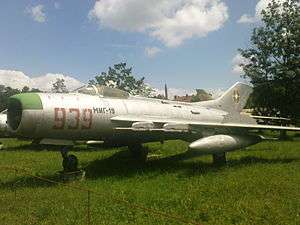 | |
| Role | Fighter |
| Manufacturer | Mikoyan-Gurevich OKB |
| First flight | 27 May 1952 |
| Introduction | March 1955 |
| Status | In service with DPRK Air Force |
| Primary users | Soviet Air Force People's Liberation Army Air Force |
| Number built | 2,172 (excluding production in China) |
| Variants | Shenyang J-6 Nanchang Q-5 |
The Mikoyan-Gurevich MiG-19 (Russian: Микоян и Гуревич МиГ-19) (NATO reporting name: "Farmer") is a Soviet second-generation, single-seat, twin jet-engined fighter aircraft. It was the first Soviet production aircraft capable of supersonic speeds in level flight. A comparable U.S. "Century Series" fighter was the North American F-100 Super Sabre, although the MiG-19 would primarily oppose the more modern McDonnell Douglas F-4 Phantom II and Republic F-105 Thunderchief over North Vietnam.
Design and development
On 20 April 1951, OKB-155 was given the order to develop the MiG-17 into a new fighter called "I-340", which was to be powered by two Mikulin AM-5 non-after-burning jet engines (a scaled-down version of the Mikulin AM-3) delivering 19.6 kN (4,400 lbf) of thrust. The I-340 was supposed to attain 1,160 km/h (630 kn; 720 mph) (Mach 1) at 2,000 m (6,600 ft), 1,090 km/h (590 kn; 680 mph) (Mach 0.97) at 10,000 m (33,000 ft), climb to 10,000 m (33,000 ft) in 2.9 minutes, and have a service ceiling of no less than 17,500 m (57,400 ft). The new fighter, internally designated "SM-1", was designed around the "SI-02" airframe (a MiG-17 prototype) modified to accept two engines in a side-by-side arrangement and was completed in March 1952.
The I-340 suffered from poor cockpit pressurization and the engines proved temperamental with frequent flameouts and surges with rapid throttle movements. The engines were upgraded to the AM-5A standard delivering 21.1 kN (4,700 lbf) of thrust each, which exceeded the power output of the Klimov VK-1F in afterburner while providing better fuel economy. The SM-1 was barely supersonic, reaching 1,193 km/h (644 kn; 741 mph) at 5,000 m (16,000 ft) (Mach 1.03). This performance was deemed insufficient for the new supersonic fighter and an after-burning version of the engine, the AM-5F, was proposed. While not implemented, the AM-5F served as the basis for the Tumansky RD-9 which powered production aircraft. Further development of the twin-engine concept resulted in a government request for the "I-360", internally designated "SM-2", powered by the AM-5F engines, but featured a highly swept wing.
The I-360 (SM-2), built in 1952, had 1.6 m (5.2 ft) longer fuselage, wingspan reduced to 9.04 m (29.7 ft), and weight increased to 6,802 kg (14,996 lb) and a new 55° sweep wing. The Nudelman N-37D cannon were moved to the wing roots to open space in a nose for the radar. Cockpit and landing gear were redesigned and a vertical stabilizer of increased area mounting a T-tail was fitted. In April 1952 the first prototype was sent to the Letno-Issledovatel'skiy Institut (en:flight research institute) (LII), flying for the first time on 27 May 1952 by G. A. Sedov. It was immediately clear that the AM-5A engines were not powerful enough, and they were replaced with AM-5F delivering 21.09–26.49 kN (4,740–5,960 lbf) (dry - wet), allowing a maximum speed of M=1.19 in horizontal flight. Flight testing prompted modifications to the air-brakes and control surfaces, re-designated as the SM-2A and after further modifications the prototype was re-designated again as the SM-2B.
The second prototype, SM-2/2 introduced horizontal stabilizers mounted on the upper rear fuselage and guns with shorter barrels. However the AM-5F engine was still not considered powerful enough, and both prototypes received yet more powerful 25.5–31.9 kN (5,700–7,200 lbf) (dry - wet) Mikulin AM-5B engines. Production versions of the AM-5 (Tumansky RD-9) were re-designated RD-9B and the SM-2B was re-designated SM-9/1 when these engines were fitted, effectively becoming the prototype of the MiG-19 series, flying for the first time on 5 January 1954, piloted by G. A. Sedov, making a total of 132 flights. Final changes included a modified air intake, new 23 mm (0.906 in) Nudelman-Rikhter NR-23 guns with 340 rpg, RSIU-3M "Klen" radio, "Uzel-1" transponder, and SRDM-1M "Konus" radio-rangefinder.
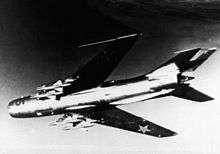
Initial enthusiasm for the aircraft was dampened by several problems, the most alarming inherited from MiG-15/MiG-17 was the danger of mid-air tank implosions when more than half of the fuel had been used - the leaking fuel of the crushed fuselage fuel tanks located between the engines would then ignite, leading to a fatal explosion; deployment of air-brakes at high speeds caused a high-g pitch-up; elevators lacked authority at supersonic speeds; high landing speed of 230 km/h (120 kn; 140 mph). Absence of a two-seat trainer version, slowed pilot transition to the type. Handling problems were addressed with the second prototype, SM-9/2, which added a third ventral air-brake and introduced all-moving tail-planes with a damper to prevent pilot-induced oscillations (PIO) at subsonic speeds, flying for the first time on 16 September 1954, entering initial production as the MiG-19.
The Soviet of The Ministers of the Soviet Union issued an order #286-133 to start serial production on 17 February 1954 at factories in Gorkiy and Novosibirsk. Factory trials were completed on 12 September 1954, and government trials started on 30 September. Problems with the initial production MiG-19, were addressed in the SM-9/3 prototype which pre-saged the MiG-19S production version, which supplanted the initial MiG-19 in production at Gorkiy and Novosibirsk from June 1956.
Approximately 5,500 MiG-19s of all versions were produced, in the USSR, Czechoslovakia as the Avia S-105 and People's Republic of China as the Shenyang J-6. The aircraft saw service with a number of other national air forces, including those of Cuba, North Vietnam, Egypt, Pakistan, and North Korea. The aircraft saw combat during the Vietnam War, the 1967 Six Day War, and the 1971 Bangladesh War.
All Soviet-built MiG-19 variants were single-seaters only, although the Chinese developed the Shenyang JJ-6 trainer version of the Shenyang J-6. With stabilization problems and "numerous crashes", the Russians had lost faith in the MiG-19, and moved on to the newly emerging MiG-21.[1]
The J-6 remained a staple of the Chinese People's Liberation Army Air Force until the 1980s and has also been developed into the Nanchang Q-5 (NATO reporting name "Fantan") attack aircraft. Despite its age, the MiG-19 and its descendants exhibit good handling characteristics at low altitude and a surprisingly high rate of climb, and their heavy cannon armament, (a one-second burst from three 30 mm (1.181 in) Nudelman-Rikhter NR-30 cannon had a total projectile mass of 18 kg (40 lb) making the MiG-19 a formidable adversary in close combat.
Russian built MiG-19s were still in service in North Korea and Zambia as of 2014.
Operational history
During their service with Soviet Anti-Air Defense and in East Germany, MiG-19s were involved in multiple interceptions of Western reconnaissance aircraft. The first documented encounter with a Lockheed U-2 took place in the autumn of 1957. The MiG-19 pilot reported seeing the aircraft, but could not make up the 2,234 m (7,000 ft) difference in altitude. When Francis Gary Powers's U-2 was shot down in the 1960 incident, one pursuing MiG-19P was also hit by the salvo of S-75 Dvina (NATO: SA-2 "Guideline") missiles, killing the pilot Sergei Safronov. In a highly controversial incident, on 1 July 1960, a MiG-19 shot down an RB-47H (S/N 53-4281) reconnaissance aircraft in international airspace over the Arctic Circle with four of the crew killed and two captured by the Soviets (they were released in 1961). In another incident, on 28 January 1964, a MiG-19 shot down a T-39 Sabreliner which had strayed into East German airspace while on a training mission; all three crewmembers were killed.
Vietnam War
Hanoi decided in early 1969 to strengthen its air defenses by creating a third jet fighter unit; the 925th Fighter Regiment. This unit would consist of late model MiG-17s and the newly acquired MiG-19s (nearly all of which were J-6s from the People's Republic of China (PRC)). The regiment was established at Yen Bai, and by April 1969, nine combat-rated MiG-19 pilots were posted for combat duty. While some of North Vietnam's MiG-17s and all of their MiG-21s were supplied by the Soviet Union, the MiG-19s (J-6 models) were supplied by the PRC, which seldom exceeded 54 MiG-19s in number.[2]
The first use and loss of a U.S. fighter to a MiG-19 (J-6) was in 1965 when a USAF Lockheed F-104 Starfighter piloted by Captain Philip E. Smith was attacked by a People's Liberation Army Air Force aircraft over Hainan Island. His Starfighter took cannon fire which damaged a portion of his wing and missile mount. Smith gave chase and did receive missile tone on the MiG but, within a millisecond of pressing his missile firing button, his Starfighter lost all power. He ejected and was captured. Smith was held prisoner until released on 15 March 1973, due to improving US-China relations following U.S. President Richard Nixon's visit to China in 1972.[3][4]
The North Vietnamese Air Force began receiving the MiG-19 at the end of Operation Rolling Thunder, which ended in 1968. Despite their limited numbers, MiG-19s were involved in extensive combat during Operations Linebacker 1 and Linebacker 2 (aka the Christmas Bombing). The NVAF claimed only seven victories over U.S. aircraft, using the MiG-19, all of which were F-4 Phantom IIs.[5] The MiG-19 was tested by U.S. pilots in the United States in 1969 after receiving a Chinese J-6 (F-6 exported model) from Pakistan.[N 1][6] In addition to finding the aircraft to have a good canopy allowing good visibility for the pilot, along with 3 hard hitting 30mm cannons, U.S. pilots found the MiG-19 (J6/F6) to be an excellent fighter, "like the MiG-17, it could easily out-turn the Phantom...and could out-accelerate the F-4 out to Mach 1.2, but was slower than the MiG-21.".[7] However, the MiG-19's strongest fault was its extremely short range, as one U.S. test pilot remarked, "after going in full after-burner at low altitude for 5 minutes, the MiG driver will be looking for a place to land!"[8] This, combined with the aircraft's twin engines, which were difficult to maintain, made the MiG-19 unpopular with North Vietnamese pilots.[9]
North Vietnamese Air Force (NVAF) and Communist Chinese air-space violation air-to-air kills; all 6 with 30mm cannon.
| Date | MiG-19 unit | Aircraft destroyed | Destroyed aircraft unit/comments |
|---|---|---|---|
| 9-20-1965 | Unknown | F-104C Starfighter | USAF 435th Tactical Fighter Squadron/Downed by Chinese MiGs.[12][13] |
| 8-21-1967 | Unknown | (2) A-6 Intruders | USN VA-196/Downed by Chinese MiGs[14] |
| 5-10-1972 | 925th Fighter Regiment (FR) | F-4D Phantom II | USAF 555th TFS |
| 5-10-1972 | 925th FR | F-4E | USAF 58th TFS |
| 5-18-1972 | 925th FR | F-4D | USAF 421st TFS |
The MiG-19 lacked mounts for air-to-air missiles but it had the one advantage over the early model F-4 Phantom II: it was armed with a cannon. NVAF MiG-19s had three 30mm cannons which "were notable for their large muzzle flash"[15] when fired. The aircraft were loaded with 90 rounds per cannon, giving approximately 6 seconds of firing time. A single 2 second burst of 90 shells could impact a U.S. aircraft with 81 lb (37 kg) of metal.[16] This contrasted to a U.S. 20mm cannon such as the Vulcan which would deliver 39 pounds of metal.[17]
Confirmed aerial victories by MiG-19s while assigned to the 925th FR, which match U.S. records occurred on: 10 May 1972 in which two F-4 Phantoms were shot down by MiG-19s flown by Pham Hung Son and Nguyen Manh Tung. Both NVAF victories over the F-4s were accomplished by cannon fire.[18][19][20] Combat results of the 925th FR using MiG-19s, according to the North Vietnamese Air Force were: two F-4s on 8 May 1972; two F-4s on 10 May 1972; one F-4 on 18 May 1972; and two F-4s shot down on 23 May 1972;[5] these losses were in exchange for 10 MiG-19s lost in aerial combat with U.S. jets. On 2 June 1972, in the skies over North Vietnam, a MiG-19 was the first recorded jet fighter to be shot down in aerial combat by cannon fire at supersonic speeds,[21] by a USAF F-4 Phantom flown by Phil Handley.
China
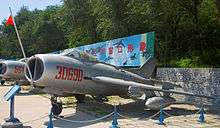
The MiG-19 was in front line service with the PLAAF, and saw limited combat against the Nationalist opponent, the Republic of China Air Force (Nationalist China). One major air battle between Communist and Nationalist Chinese aircraft occurred in 1967, with 12 J-6s taking on four Lockheed F-104 Starfighters. Each side claimed one kill.
Reports surfaced of People's Republic of China J-6s (MiG-19s) flying combat missions during infrequent border squabbles with the Soviets, though with no records of dogfights, and encounters during the Vietnam War with U.S. aircraft that strayed into Chinese airspace. These confrontations resulted in a few losses of U.S. aircraft, with no recorded losses of Chinese aircraft, although the MiGs made hasty retreats back into the safety of Chinese airspace before the Americans could respond with reinforcements.
Middle East
In 1962, Egyptian MiG-19s saw some action in the ground-attack role during the civil war in Yemen during the early 1960s. The first reported air combat in the Mideast with the MiG-19 was on 29 November 1966, when two Egyptian MiG-19 fighters battled Israeli Mirage IIICs. The Israelis claimed two kills and no losses. Around 80 MiG-19s were in service with Egypt during the Six-Day War in 1967, but more than half were destroyed on the ground during the opening Israeli airstrikes of Operation Focus. Israeli pilots, however, did find the MiG-19 a potentially dangerous adversary because of its performance, maneuverability, and heavy armament.
Following the war, the Egyptians organized the surviving MiG-19 aircraft and assigned them air defense tasks of Egypt's interior. The Soviet Union did not supply Egypt with any replacement of the MiG-19s destroyed in the Six Day War, but Egypt might have received some from Syria and Iraq, so that by the end of 1968 there were 80+ MiG-19s in service with the Egyptian Air Force (EAF). The aircraft also saw combat during the War of Attrition; in one engagement on 19 May 1969, a MiG-19 aircraft engaged two Israeli Mirages, shooting down one with cannon fire while the other escaped.[22] Egypt had around 60 Mig-19s in service during the Yom Kippur War of 1973 in which they served as close air support aircraft.
The Iraqis obtained some MiG-19S fighters in the early 1960s, but later sold them all off (a couple remaining in local museums), though the survivors did see some action against the Kurds in the 1960s. It is claimed that the Iranians acquired a batch of their own F-6s.
Horn of Africa
In the Horn of Africa, the Somali Armed Forces flew the F-6 against the Ethiopian National Defense Force during the Ogaden campaign. The SAF also used the aircraft against rebel positions in the late 1980s.
Nile Valley
In the Nile Valley, Sudan used its MiG-19S fighters against separatists in southern Sudan. At least one such aircraft was shot down.
African Great Lakes
In the African Great Lakes region, Tanzania flew MiG-19S fighters against Uganda during the war between the two states in 1978 and 1979.
Variants


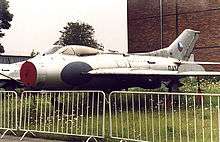
Production aircraft designations
Data from::[23]
- MiG-19 (NATO reporting name - "Farmer-A"; OKB- SM-9/1)[24]
- First production version armed with 3 23 mm NR-23 cannon.
- MiG-19P (NATO - "Farmer-B"; OKB - SM-7)[24]
- Version equipped with RP-1 Izumrud radar in the nose and armed with 2 23 mm NR-23 (later 2 30 mm NR-30) cannons in the wings. Had provision for an unguided rocket pack under each wing, elongated tailfin fillet, all-moving tailplane, third airbrake added behind the ventral fin. Vympel K-13 (AA-2 'Atoll') air-to-air missile (AAM) capability was added late in its service life; entered production in 1955.
- MiG-19PF
- Single-seat radar-equipped, all-weather interceptor fighter aircraft; built in small numbers.
- MiG-19PG
- MiG-19P equipped with the Gorizont-1 ground control datalink.
- MiG-19PM (NATO
- "Farmer-E")
- Variant with removed cannons, armed with 4 Kaliningrad K-5M (NATO: AA-1 "Alkali") beam-riding missiles. Entered production in 1957.
- MiG-19PML
- MiG-19PM with Lazur ground control datalink.
- MiG-19PU
- Rocket pack fit similar to MiG-19SU.
- MiG-19PT
- A single MiG-19P equipped to carry Vympel K-13 (NATO: AA-2 "Atoll") missiles.
- MiG-19PU
- MiG-19R
- Reconnaissance version of the MiG-19S with cameras replacing the nose cannon and powered by uprated RD-9BF-1 engines.
- MiG-19S (NATO - "Farmer-C"; OKB - SM-9/3)[24]
- Further development equipped with Svod long-range navigation receiver and armed with 3 30 mm NR-30 cannons. Had provisions for an unguided rocket pack or a FAB-250 bomb under each wing; entered service in 1956.
- MiG-19SF
- Late production MiG-19S powered by the same uprated RD-9BF-1 engines as the MiG-19R.
- MiG-19SV
- High-altitude version for intercepting reconnaissance balloons, reached 20,740 m (68,040 ft) on 6 December 1956; entered service in 1956.
- MiG-19SMK
- two missile guidance testbeds for the K-10S cruise missile system.
- MiG-19SVK
- MiG-19SV with a new wing, small increase in altitude above MiG-19SV; did not warrant production.
- MiG-19SU (OKB SM-50)[24]
- High-altitude version to intercept the Lockheed U-2, equipped with a self-contained liquid-fuel booster rocket pack; appears to have been abandoned because of inability to control the aircraft at very high altitudes and the aircraft's tendency to enter supersonic spins.
- MiG-19M
- Target drones converted from the MiG-19 and MiG-19S (M- mishen' - target.
- SL-19
- A research aircraft modified from a MiG-19 with a variable track / skid-base skid undercarriage (SL- samolyot-laboatoriya - aircraft laboratory).
- M-19
- an alternative designation for the MiG-19M
- M-19M
- an alternative designation for the MiG-19M
OKB designations
- SM-6
- Two MiG-19Ps converted to flying laboratories for testing the Grushin K-6 developmental AAM (intended for the Sukhoi T-3 jet fighter) and Almaz-3 radar.
- SM-7
- Three prototypes of the MiG-19P all-weather interceptor, (SM-7/1, SM-7/2 andSM-7/3), built concurrently with the SM-9 prototypes, exhibiting all the same failings.
- SM-9/1
- first prototype of the MiG-19 series, developed from the SM-2.
- Sm-9/2
- prototype of the initial MiG-19 production series.
- Sm-9/3
- prototype of the tactical fighter MiG-19S production series.
- Sm-9/9
- projected tactical nuclear strike version, abandoned due to poor performance estimates with the weapon loaded
- SM-12
- New fighter prototype, developed into the MiG-21; four aircraft built.
- SM-20
- Missile simulator for testing the Raduga Kh-20 (NATO: AS-3 "Kangaroo") cruise missile.
- SM-30
- Zero-length launch (ZeLL) version with PRD-22R short-duration burn booster rocket.
- SM-50
- :High-altitude version (MiG-19SU) to intercept the Lockheed U-2, equipped with a self-contained liquid-fuel booster rocket pack; appears to have been abandoned because of inability to control the aircraft at very high altitudes and the aircraft's tendency to enter supersonic spins.
- SM-51
- High-altitude experimental version, (MiG-19PU), fitted with a U-19 booster rocket.
- SM-52
- High-altitude experimental version, (MiG-19PU), fitted with a Sevrook re-usable booster rocket.
- SM-K
- Missile simulator for testing the Raduga K-10 (NATO: AS-2 "Kipper") cruise missile.
izdeliye designations
- izdeliye 59
- internal GAZ-21 (Gor'kiy) designation of the MiG-19 initial production series.
- izdeliye 25
- internal GAZ-153 (Novosibirsk) designation of the MiG-19 initial production series.
- izdeliye 61
- internal GAZ-21 (Gor'kiy) designation of the MiG-19S production series.
- izdeliye 62
- internal GAZ-21 (Gor'kiy) designation of the MiG-19P production all-weather interceptor.
- izdeliye 26
- internal GAZ-153 (Novosibirsk) designation of the MiG-19S production series.
- izdeliye 61
- internal GAZ-21 (Gor'kiy) designation of the SM-12PMU
- izdeliye SM-2/A
- a weapon system development MiG-19 for ground attack weapons.
- izdeliye SM-2/B
- a weapon system development MiG-19 for ground attack weapons.
- izdeliye SM-2/G
- a weapons test-bed for ARS-160 HVARs, discontinued when the SM-2/G was almost complete.
- izdeliye SM-2/I
- a weapons test-bed for the K-6 air-to-air missile.
- izdeliye SM-2/M
- a weapons test-bed for the K-5M (RS-2-U) air-air missile.
- izdeliye SM-2/V
- a weapon system development aircraft for ground attack weapons, converted from the izdeliye SM-2/B.
- izdeliye SM-6
- a weapons test-bed for the K-6 air-air missile.
- izdeliye SM-9K
- possible alternative designation for the izdeliye SM-30
- izdeliye SM-9R
- OKB designation for the MiG-19R tactical reconnaissance aircraft.
- izdeliye SM-9V
- OKB designation for the MiG-19SV high altitude interceptor prototypes with MiG-19 rear fuselage / tail unit.
- izdeliye SM-9V/3-V
- OKB designation for the MiG-19SV high altitude interceptor with MiG-19S rear fuselage / tail unit.
- izdeliye SM-9V/3-VK
- OKB designation for the MiG-19SVK experimental high altitude interceptor.
- izdeliye delta SM-9
- weapons aiming testing with the ASP-5N computing gunsight and SRD-1 gun ranging radar.
- izdeliye SM-9/3T
- a MiG-19S modified to test the K-13 / R-3S (NATO - AA-2 Atoll).
- izdeliye SM-7
- the SM-7 all-weather interceptor prototypes.
- izdeliye SM-7/3
- the MiG-19P production all-weather interceptor.
- izdeliye SM-7A
- OKB designation for a MiG-19P weapons test-bed with gun armament.
- izdeliye SM-7M
- OKB designation for a MiG-19P weapons test-bed with missile armament.
- izdeliye SM-7/1M
- the first SM-7 prototype modified with the K-5M missile system to be fitted in the MiG-19PM.
- izdeliye SM-7/2M
- the second SM-7 prototype and five MiG-19P aircraft modified with the K-5M missile system to be fitted in the MiG-19PM.
- izdeliye 65
- internal GAZ-21 (Gor'kiy) designation of the MiG-19PM production series.
- izdeliye SM-7/2T
- A single MiG-19P equipped to carry Vympel K-13 (NATO: AA-2 "Atoll") missiles as the MiG-19PT.
- izdeliye SM-9D
- possible alternative designation for the izdeliye SM-10.
- izdeliye SM-10
- an in-flight refuelling test-bed aircraft using the wing-tip to wingtip hose system.
- izdeliye SM-11
- a projected version of the MiG-19S fitted with a Yastreb-SIV-52 infra-red search and track system.
- izdeliye SM-12
- prototypes fitted with extended nose and new intake system from the Ye-2A and Ye-5 research aircraft.
- izdeliye SM-12/3T
- the third SM-12 prototype modified to carry K-13A AAMs for testing.
- izdeliye SM-12/4T
- the fourth SM-12 prototype modified to carry K-13A AAMs for testing.
- izdeliye SM-12PM
- intended production version of the SM-12 armed with the K-51 weapon system.
- izdeliye SM-12PMU
- the second SM-12 prototype fitted with a U-19D booster rocket in an identical installation to the MiG-19SU.
- izdeliye SM-20
- missile simulators used to test the guidance systems for the Kh-20 (NATO - AS-3 Kangaroo) missile, air-dropped from a Tupolev Tu-95 mother-ship.
- izdeliye SM-21
- the SM-2/V converted, for the third time, to test the APU-5 launch rails on outboard hard-points.
- izdeliye SM-20P
- alternative designation for the SM-20/1 manned missile simulator (P - peeloteerooyernyy)
- izdeliye SM-30
- zero-length launch (ZeLL) test-beds with PRD-22R booster rocket.
- izdeliye SM-30/3
- projected production zero-length launch (ZeLL) fighters.
- izdeliye SM-50
- :High-altitude version (MiG-19SU) to intercept the Lockheed U-2, equipped with a self-contained U-19 liquid-fuel booster rocket pack.
- izdeliye SM-51
- High-altitude experimental version, (MiG-19PU), fitted with a U-19 booster rocket.
- izdeliye SM-52
- High-altitude experimental version, (MiG-19PU), fitted with a Sevrook re-usable booster rocket.
- izdeliye SM-K
- two missile guidance test-beds, (SM-K/1 and SM-K/2), for the K-10S cruise missile system.
Licence built versions
- Avia S-105
- Czechoslovak licensed built MiG-19S.
- Shenyang J-6
- Chinese-built version of the MiG-19. This version was inducted into the Pakistani Air Force as the F-6. The F-6 was later modified by the Pakistani Air Force to carry U.S.-built AIM-9 Sidewinder missiles.
- Shenyang JJ-6
- two-seat trainer version of the J-6
Operators
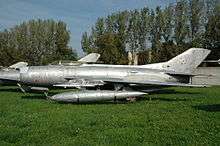
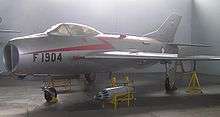
 Afghanistan
Afghanistan- Afghan Air Force. 36 acquired by the Royal Afghan Air Force from 1964.
 Albania
Albania- Albanian Air Force. 85 Soviet-built. All retired in 2005.
 Bangladesh
Bangladesh- Bangladesh Air Force
 Bulgaria
Bulgaria- The MiG-19 served in the Bulgarian Air Force from 1958 to 1973.
 People's Republic of China
People's Republic of China- Chinese-built variant Shenyang J-6, all single-seaters retired from frontline combat service in 1992, except for Nanchang Q-5 variant,[25] some J-6 was converted to target/attack drone (number not confirmed). As of 2010 all were decommissioned.
 Cuba
Cuba- Cuban Air Force
 Czechoslovakia
Czechoslovakia- Czechoslovak Air Force operated many MIG-19S, MIG-19P, MIG-19PM and licensed build S-105
 East Germany
East Germany- East German Air Force
 Egypt
Egypt- Egyptian Air Force
 Hungary
Hungary- Hungarian Air Force Operated 12 MiG-19PM from 1959 to 1973.
 Indonesia
Indonesia- Indonesian Air Force. The Indonesian Air Force acquired a number of MiG-19S in 1961 and used during the preparation of Operation Trikora in 1962 (the taking of Western New Guinea from the Netherlands) in Western New Guinea (now Papua and Papua Barat). Several of these aircraft crashed. All aircraft sold to Pakistan
 Iraq
Iraq- Iraqi Air Force
 Mozambique
Mozambique- Military of Mozambique
 North Korea
North Korea- North Korean Air Force. J-6 still in service.
 Pakistan
Pakistan- Pakistan Air Force. Operated Chinese J-6 from 1965 to 2002. Some of them are on display on squares in various cities.
 Poland
Poland- Polish Air Force. A total of 22 MiG-19P and 14 MiG-19PM interceptors served between 1957 and 1974
.svg.png) Romania
Romania- Romanian Air Force. A total of 17 MiG-19P and 10 MiG-19PM aircraft were in service between 1958 (1959 for the PM) and 1972.
 Somalia
Somalia- Somali Air Corps
 Soviet Union
Soviet Union
 Sudan
Sudan- Sudanese Air Force.
 Syria
Syria- Syrian Air Force
 Tanzania
Tanzania- Tanzanian Air Force
 Vietnam
Vietnam- Vietnam People's Air Force
 Zambia
Zambia- Zambian Air Force
Specifications (MiG-19S)

General characteristics
- Crew: 1
- Length: 12.54 m (41 ft 2 in) less pitot boom; 14.64 m (48.0 ft) with pitot boom extended
- Wingspan: 9 m (29 ft 6 in)
- Height: 3.885 m (12 ft 9 in)
- Wing area: 25.16 m2 (270.8 sq ft)
- Empty weight: 5,172 kg (11,402 lb) to 5,447 kg (12,009 lb)
- Gross weight: 7,560 kg (16,667 lb) clean
- Max takeoff weight: 8,662 kg (19,096 lb) with drop tanks
- Fuel capacity: internal:2,170 l (570 US gal; 480 imp gal); drop tanks 2x 760 l (200 US gal; 170 imp gal)
- Powerplant: 2 × Tumansky RD-9B axial flow afterburning turbojets, 25.5 kN (5,730 lbf) thrust each dry, 31.8 kN (7,160 lbf) with afterburner
Performance
- Maximum speed: 1,452 km/h (902 mph; 784 kn) at 10,000 m (33,000 ft)
- Maximum speed: Mach 1.355
- Range: 1,390 km (864 mi; 751 nmi)
- Ferry range: 2,200 km (1,367 mi; 1,188 nmi) with drop tanks
- Endurance: 1 hour 43 minutes clean ; 2 hours 38 minutes with drop tanks
- Service ceiling: 15,600 m (51,181 ft) dry : 17,500–17,900 m (57,400–58,700 ft) wet
- g limits: +8
- Rate of climb: 180 m/s (35,000 ft/min)
- Wing loading: 325 kg/m2 (66.5 lb/sq ft)
- Thrust/weight: 0.86
Armament
- Guns: 3x 30 millimetres (1.181 in) Nudelman-Rikhter NR-30 cannon (75 rpg for wing-root guns, 55 rounds for the fuselage gun)
- Bombs: 2x 50–250 kg (110–550 lb) bombs or 2x S-5 rocket pods with 4 rockets each [28]
Avionics
SRD-3 Grad gun ranging radar, ASP-5N computing gun-sight and an RSIU-4 Doob UHF radio
See also
- Related development
- Aircraft of comparable role, configuration and era
- Related lists
References
Notes
- ↑ Michel III, p. 188
- ↑ Toperczer 2001, p. 64.
- ↑ Smith and Herz p. 29–35, 67, 68, (1992)
- ↑ "Smith, Philip Eldon." pownetwork.org. Retrieved: 21 July 2011
- 1 2 Toperczer 2001, p. 90.
- ↑ Michel III-p 188,189
- ↑ Michael III, p. 189
- ↑ Michel III p. 189
- ↑ Michel III-p188,189
- ↑ Hobson p. 271
- ↑ Toperczer (#25) p. 90
- ↑ Hobson p. 32
- ↑ Smith & Herz p. 8, 12, 31
- ↑ Hobson p. 114
- ↑ Michel III p. 189, 212
- ↑ Michel III, p. 189, 312
- ↑ Michel III p. 13, 16
- ↑ Michel 1997, p. 212.
- ↑ Sherwood 1999, pp. 231–232.
- ↑ Ethell and Price 1989, pp. 55–61, 141.
- ↑ Davies #55, p. 37, 38
- ↑ Nicolle and Cooper 2004, p. 27.
- ↑ Gordon, Yefim; Komissarov, Dmitry (2009). Gordon, Yefim & Komissarov, Dmitry. OKB Mikoyan". Hinkley, Midland. 2009. ISBN 1-85780-307-8. Hinkley: Midland. pp. 131–183. ISBN 1-85780-307-8.
- 1 2 3 4 "Modifications." OKB MiG Design Bureau (Unofficial reference website). Retrieved: 21 July 2011.
- ↑ Baddeley, Adam. "The AMR Regional Air Force Directory 2011." Asian Military Review, February 2011. Retrieved: 21 July 2011.
- ↑ "MiG-19 'Farmer'". historyofwar.org. Retrieved 6 April 2015.
- ↑ "MiG-19 Characteristics". web.archive.org. Archived from the original on July 23, 2011. Retrieved 18 September 2015.
- ↑
Footnotes
- ↑ This MiG-19 is currently on display at the National Museum of the USAF in Dayton, Ohio. Courtesy of the USAF 457th Technical Evaluation Squadron, Nellis AFB, Area 51.
Bibliography
- Butowski, Piotr (with Jay Miller). OKB MiG: A History of the Design Bureau and its Aircraft. Leicester, UK: Midland Counties Publications, 1991. ISBN 0-904597-80-6.
- Crosby, Francis. Fighter Aircraft. London: Lorenz Books, 2002. ISBN 0-7548-0990-0.
- Davies, Peter E. USAF F-4 Phantom MiG Killers 1972-73 (Osprey Combat Aircraft #55). Oxford, UK: Osprey Publishing Limited, 2005. ISBN 1-84176-657-7.
- Ethell, Jeffrey and Alfred Price. One Day in a Very Long War: May 10, 1972, Air Combat, North Vietnam. New York: Random House, 1989. ISBN 978-0-517-07934-8.
- Hobson, Chris. Vietnam Air Losses, United States Air Force, Navy and Marine Corps Fixed-Wing Aircraft Losses in Southeast Asia 1961-1973. Midland Publishing (2001) England. ISBN 1-85780-115-6.
- Koenig, William and Peter Scofield. Soviet Military Power. Greenwich, Connecticut: Bison Books, 1983. ISBN 0-86124-127-4.
- Michel III, Marshall L. Clashes: Air Combat Over North Vietnam 1965-1972. Annapolis, Maryland: Naval Institute Press, 1997. ISBN 1-55750-585-3.
- Nicolle, David and Tom Cooper. Arab MiG-19 and MiG-21 Units in Combat (Osprey Combat Aircraft #44). Oxford, UK: Osprey Publishing Limited, 2004. ISBN 978-1-84176-655-3.
- Robinson, Anthony. Soviet Air Power. London: Bison Books, 1985. ISBN 0-86124-180-0.
- Sherwood, John D. Fast Movers: Jet Pilots and the Vietnam Experience. New York: Free Press, 1999. ISBN 0-312-97962-2.
- Smith, Philip E. and Peggy Herz. Journey Into Darkness: The Gripping Story of an American POW's Seven Years Trapped Inside Red China During the Vietnam War. New York: Pocket, Simon & Schuster, 1992. ISBN 0-671-72823-7.
- Sweetman, Bill and Bill Gunston. Soviet Air Power: An Illustrated Encyclopedia of the Warsaw Pact Air Forces Today. London: Salamander Books, 1978. ISBN 0-517-24948-0.
- Toperczer, István. MiG-17 And MiG-19 Units of the Vietnam War (Osprey Combat Aircraft #25). Oxford, UK: Osprey Publishing Limited, 2001. ISBN 1-84176-162-1.
External links
| Wikimedia Commons has media related to Mikoyan-Gurevich MiG-19. |
- RB-47H Shot Down – National Museum of the United States Air Force
- MiG-19 FARMER at Global Security.org.
- MiG-19 Farmer at Global Aircraft
- Cuban MiG-19